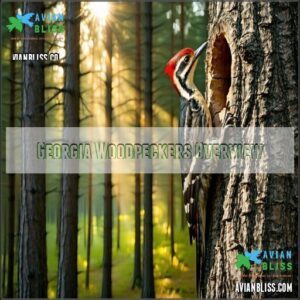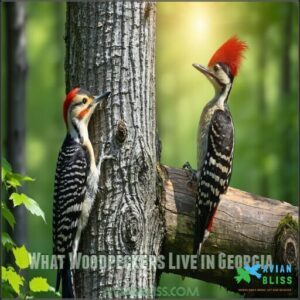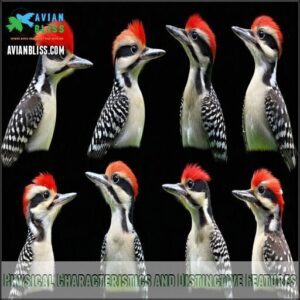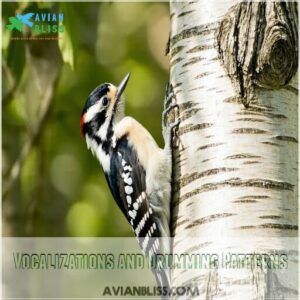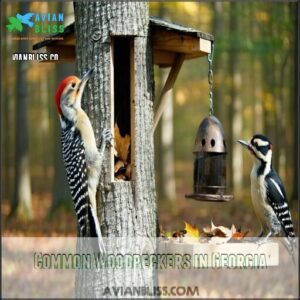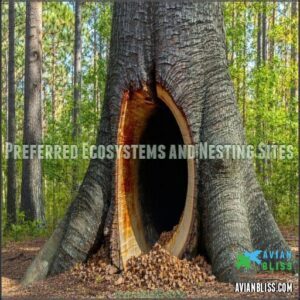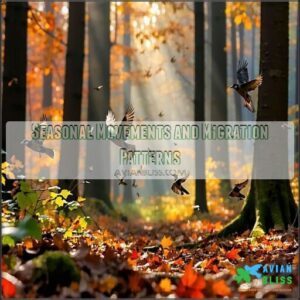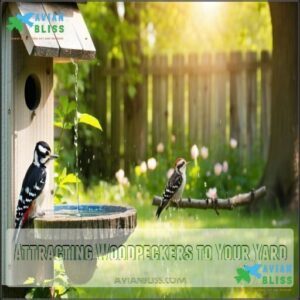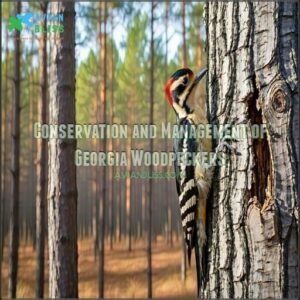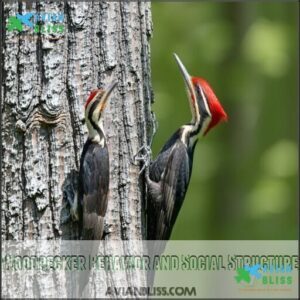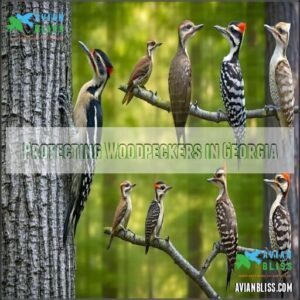This site is supported by our readers. We may earn a commission, at no cost to you, if you purchase through links.

You’ve got the tiny downy woodpecker, a backyard regular, and the massive pileated woodpecker, whose loud drumming can echo through forests.
Favorites like the red-headed and red-bellied woodpeckers add splashes of color, while the endangered red-cockaded woodpecker thrives in pine habitats.
These birds are ecosystem superheroes, helping control insect populations and creating nesting cavities others use.
Look out for them in wooded areas and even suburban yards—they’re more common than you think!
Curious about their diets or calls? Stay tuned for more.
Table Of Contents
- Key Takeaways
- Georgia Woodpeckers Overview
- What Woodpeckers Live in Georgia
- Woodpecker Identification in Georgia
- Common Woodpeckers in Georgia
- Woodpecker Habitats and Distribution
- Woodpecker Diets and Foraging Behaviors
- Attracting Woodpeckers to Your Yard
- Conservation and Management of Georgia Woodpeckers
- Woodpecker Behavior and Social Structure
- Protecting Woodpeckers in Georgia
- Frequently Asked Questions (FAQs)
- What is the most common woodpecker in Georgia?
- What bird looks like a woodpecker but isn’t?
- Are there woodpeckers in Georgia?
- Are there red-headed woodpeckers in Georgia?
- Are downy woodpeckers common in Georgia?
- What does a woodpecker look like in Georgia?
- Are pileated woodpeckers native to Georgia?
- Do woodpeckers die in Georgia?
- What does it mean when you see a woodpecker is pecking a tree?
- How to tell the difference in male and female Pileated Woodpeckers?
- Conclusion
Key Takeaways
- You’ll find nine woodpecker species in Georgia, from the tiny Downy to the large Pileated, each playing a vital role in the ecosystem.
- The Red-cockaded Woodpecker, though downlisted from endangered to threatened, still needs habitat restoration like preserving longleaf pine forests.
- Woodpeckers are natural pest controllers, feeding on insects, sap, fruits, and nuts, with unique behaviors like drumming and caching food.
- To attract woodpeckers, plant native trees, avoid pesticides, and set up suet and nut feeders while preserving dead trees for nesting.
Georgia Woodpeckers Overview
You’ll find nine remarkable woodpecker species throughout Georgia’s diverse landscapes, from the tiny Downy to the impressive Pileated woodpecker.
While most species like the Red-bellied Woodpecker thrive in Georgia’s forests and suburban areas, conservation efforts continue for the endangered Red-cockaded Woodpecker, which requires mature pine forests for its survival.
Diversity of Woodpeckers in Georgia
Georgia’s forests echo with the rhythmic drumming of remarkable woodpecker diversity. When exploring the state’s varied ecosystems, you’ll discover an impressive array of these specialized birds.
- Georgia hosts nine distinct woodpecker species, each displaying unique morphological variations and behavioral differences
- Species richness spans from the tiny Downy to the massive Pileated woodpecker
- Niche partitioning allows these birds to coexist by specializing in different feeding zones
This genetic diversity creates a fascinating mosaic of woodpecker species across Georgia’s landscapes, from coastal plains to mountain forests. The similar Downy and Hairy woodpeckers display subtle plumage differences that aid identification.
Threatened Woodpecker Species in Georgia
While Georgia boasts impressive woodpecker diversity, several species face serious threats in 2025. The red-cockaded woodpecker, though no longer officially endangered, remains at risk due to habitat loss and small population challenges.
The red-cockaded woodpecker thrives in Georgia, but habitat loss continues to challenge this once-endangered species’ survival.
Conservation efforts for these threatened Georgia woodpeckers include:
- Habitat restoration through initiatives like the Longleaf Landscape Stewardship Fund
- Population growth through recruitment clusters on military installations
- Public-private partnerships working to establish over 15,000 new acres of longleaf pine forest
The ivory-billed woodpecker is considered extinct, with no conclusive evidence of recent sightings.
What Woodpeckers Live in Georgia
The Peach State hosts nine fascinating woodpecker species, each with distinctive characteristics and habitats.
While exploring Georgia’s diverse ecosystems, you’ll encounter these remarkable birds drumming away at trees.
Like their Texas counterparts, woodpeckers in Georgia play a vital role in controlling insect populations.
| Species | Status | Habitat | Size | Identification Tip |
|---|---|---|---|---|
| Red-bellied | Common | Woodlands | 9.4 in | Red cap, zebra back |
| Downy | Abundant | Mixed forests | 6.7 in | Smallest, spotted wings |
| Hairy | Common | Mature forests | 9.3 in | Larger bill than Downy |
| Pileated | Uncommon | Old growth | 17.5 in | Flaming red crest |
| Red-headed | Decreasing | Open woods | 9.0 in | Entirely red head |
The woodpeckers in Georgia are an essential part of the ecosystem, and understanding their diverse ecosystems and habitats is crucial for their conservation.
The remarkable birds can be identified by their unique characteristics, such as the red cap and zebra back of the Red-bellied woodpecker.
Woodpecker Identification in Georgia
You’ll spot Georgia’s nine woodpecker species more easily once you know their distinct patterns of black, white, and red feathers, with most males showing bright red patches on their heads.
From the tiny Downy Woodpecker measuring just 6 inches to the crow-sized Pileated Woodpecker reaching 17 inches, each species has unique field marks that you’ll quickly recognize with practice, allowing you to identify them by their distinct patterns.
Physical Characteristics and Distinctive Features
Every Georgia woodpecker species showcases distinctive physical characteristics that make identification a fascinating pursuit for birdwatchers.
- Plumage Coloration: Most species display striking black and white patterns with vibrant red accents, particularly on males’ heads
- Beak Morphology: Strong, chisel-like bills perfectly adapted for drilling into wood
- Crest Variations: From the Pileated’s flaming red crest to the subtle red patch on Downy Woodpeckers
- Sexual Dimorphism: Males typically feature more extensive red markings than females
- Facial Patterns: Unique cheek stripes, eye lines, and throat markings serve as key identification markers
These woodpecker characteristics create nature’s perfect toolkit—combining specialized beaks, stiff tail feathers for support, and zygodactyl feet (two toes forward, two backward) for superior climbing abilities.
Size and Wingspan Comparisons
When comparing Georgia woodpeckers, size and wingspan serve as essential identification markers for birdwatchers in the field.
From the diminutive Downy Woodpecker measuring just 6-7 inches in length with a modest 9.8-11.8 inch wingspan, to the impressive Pileated Woodpecker stretching 16-19 inches with wingspans reaching 29.5 inches, these birds display remarkable size variation.
The mid-sized Red-headed Woodpecker falls between at 7-9 inches with a 16.5-inch wingspan.
Sexual dimorphism in size is subtle among woodpecker species, with males typically slightly larger than females.
- Downy comparison: Our smallest woodpecker, often confused with its larger Hairy cousin
- Flicker wingspan: Distinctive 16-20 inch spread with noticeable white rump patch in flight
- Pileated size: Crow-sized forest giant, unmistakable when soaring between trees
Vocalizations and Drumming Patterns
While measuring woodpeckers by size helps with identification, their sound signatures are equally revealing. You’ll discover each species has its own unique vocal repertoire and drumming patterns across Georgia’s forests.
The species of woodpeckers can be identified by their distinct characteristics, as shown in the table below:
| Species | Drumming Pattern | Vocal Calls |
|---|---|---|
| Downy | Short, even roll | Sharp "pik" notes |
| Pileated | Slow, resonant 3-second rolls | Loud "cuk-cuk-cuk" calls |
| Red-bellied | Machine-gun bursts | Rolling churr sounds |
| Northern Flicker | Variable rhythm | Laugh-like "ha-ha-ha-ha" |
| Yellow-bellied Sapsucker | Morse code-like tapping | "Wika-wika" complaints |
Listen carefully to these woodpecker sounds in the morning hours when drumming activity peaks. Both males and females drum, especially during mating season, with stronger patterns indicating healthier birds. Their drumming serves multiple purposes: attracting mates, establishing territories, and communication between partners.
Understanding geographic location’s impact on vocalizations can further refine species identification. Sound analysis can help even novice birders identify species without visual confirmation, making it a valuable tool for bird identification and research.
Common Woodpeckers in Georgia
You’ll spot eight common woodpecker species across Georgia’s diverse landscapes, including the striking Red-bellied Woodpecker with its zebra-patterned back and the massive Pileated Woodpecker that leaves rectangular holes in trees.
From the tiny Downy Woodpecker that visits backyard feeders to the ground-foraging Northern Flicker, each species offers unique behaviors and markings that you can observe year-round.
Red-cockaded Woodpecker
After identifying unique woodpecker markings, let’s spotlight Georgia’s conservation success story—the Red-cockaded Woodpecker.
Recently downlisted from endangered to threatened status in 2025, these remarkable birds have made a comeback with over 1,500 family groups now in Georgia. You’ll recognize them by their black and white plumage with males displaying a tiny red streak or "cockade."
Five fascinating facts about Red-cockaded Woodpeckers:
- They’re the only woodpecker species that excavates cavities in living pine trees, a process that can take 1-3 years
- They practice cooperative breeding where offspring help parents raise new broods
- Their cavity trees often have resin wells that create sticky barriers against predators
- Georgia maintains 76 protected population sites across the state
- Recovery efforts include prescribed burns to maintain their open pine habitat
Red-headed Woodpecker
While the Red-cockaded Woodpecker faces conservation challenges, the Red-headed Woodpecker captivates with its unmistakable appearance.
This stunning Georgia woodpecker sports a completely crimson head contrasting sharply with its black-and-white plumage variations.
Unlike other woodpecker species, both males and females share identical markings, making woodpecker identification straightforward for bird watchers.
- Masters of aerial insect catching, snatching prey mid-flight
- Notorious for their omnivorous diet, consuming everything from beetles to bird eggs
- Known for aggressive behavior when defending territory
- Practitioners of "caching," storing nuts and acorns in tree crevices
Unfortunately, these beautiful Georgia birds face significant population decline due to habitat loss, making each sighting increasingly precious.
Red-bellied Woodpecker
While the red-headed woodpecker flaunts its crimson cap, you’ll likely spot the red-bellied woodpecker more often in Georgia’s woodlands and urban backyards.
Don’t let the name fool you—their pale belly sports just a hint of red, with their zebra-striped back and red crown being more distinctive features.
These Georgia woodpeckers show remarkable adaptability:
- Cavity architects creating elaborate homes in both dead and living trees
- Dietary opportunists enjoying insects, nuts, fruits, and birdseed
- Urban adapters thriving in suburban neighborhoods and city parks
- Population thrivers maintaining stable numbers despite habitat changes
Downy Woodpecker
The Downy Woodpecker stands as Georgia’s smallest woodpecker species, a true miniature marvel at only 6-7 inches long.
Unlike its flashier red-bellied cousin, these black-and-white acrobats prefer subtle elegance with males sporting just a small red patch on their nape.
You’ll recognize their distinctive "pik" calls and gentle drumming throughout Georgia’s woodlands.
Their diet consists primarily of insects, though they’ll happily visit suet feeders in your backyard.
Downy nesting cavities appear in dead tree limbs, where they raise their young.
Watch carefully—they’re often confused with their larger Hairy Woodpecker lookalikes.
Hairy Woodpecker
You’ll often spot the Hairy Woodpecker showing off its striking black-and-white pattern throughout Georgia’s mature forests.
Larger than its Downy lookalike, this species features a distinctively longer, chisel-like bill perfect for deeper bark excavation.
- Hairy Habitat: Prefers older growth forests with substantial dead trees
- Hairy Diet: Primarily consumes wood-boring beetles, ants, and caterpillars
- Hairy Behavior: Produces powerful drumming and sharp "peek" calls
- Hairy Identification: Look for white outer tail feathers and lack of black spots
These year-round Georgia residents bring natural pest control to our woodlands.
Northern Flicker
Unlike its tree-clinging cousins, the Northern Flicker prefers ground foraging, making it a unique sight among Georgia woodpeckers.
The Northern Flicker, Georgia’s ground-foraging woodpecker, dazzles with spotted plumage and flashes of yellow underwings in flight.
You’ll recognize this beautiful species by its spotted breast, brown barring, and flash of yellow underwings in flight.
Listen for their loud "wicka-wicka-wicka" calls while birdwatching in Georgia‘s open woodlands and forest edges.
These woodpeckers have impressive appetites, consuming thousands of ants in a single feeding session.
During migration patterns, some Northern Flickers move southward through Georgia, though many remain year-round.
They create nesting cavities in dead trees where both parents share incubation duties and chick-rearing responsibilities.
Pileated Woodpecker
While Northern Flickers prefer the ground, the magnificent Pileated Woodpecker reigns as Georgia’s largest woodpecker species.
You’ll recognize this crow-sized forest architect by its flaming red crest and powerful excavation skills.
- Look for distinctive rectangular holes in dead trees – telltale signs of Pileated Woodpeckers hunting carpenter ants, their primary diet.
- Listen for their loud, laughing calls echoing through mature woodlands, where habitat loss threatens their nesting habits.
Woodpecker Habitats and Distribution
You’ll find Georgia’s nine woodpecker species in diverse habitats ranging from pine forests where red-cockaded woodpeckers thrive to suburban yards where downy woodpeckers frequently visit your feeders.
Throughout the state, you’ll notice distinct distribution patterns with some species like the red-bellied woodpecker appearing year-round while others, such as the yellow-bellied sapsucker, only grace Georgia’s landscapes during winter months.
Preferred Ecosystems and Nesting Sites
Each Georgia woodpecker species has evolved unique forest preferences that influence where they build their homes.
From dense woodlands to open pine forests, these remarkable birds select specific environments based on their needs.
Pileated woodpeckers favor mature forests with large trees and high snag density, creating extensive cavity systems in dead trunks.
Red-cockaded woodpeckers exclusively choose living longleaf pines, where they painstakingly excavate nests over months or years.
Nesting materials vary by species, with some lining cavities with wood chips while others use minimal cushioning.
Cavity size directly correlates with the bird’s dimensions—tiny Downy woodpeckers need just 1-2 inch entrances, while the mighty Pileated requires 3-4 inch openings.
Habitat fragmentation increasingly threatens these specialized nesters across Georgia’s changing landscape, affecting their ability to find suitable forest preferences and extensive cavity systems.
Geographic Range Within Georgia
Georgia woodpeckers thrive in distinctly different regions across the state, from Mountain Regions to the Coastal Plain.
- Red-headed Woodpeckers favor open woodlands of the Piedmont Distribution
- Pileated Woodpeckers flourish in mature forests statewide
- Red-cockaded Woodpeckers cling to remaining longleaf pine sanctuaries
- Downy Woodpeckers adapt to almost any wooded area, even amid Urban Encroachment
Each species shows remarkable Habitat Specificity. You’ll find Red-bellied Woodpeckers in nearly every Georgia county, while the endangered Red-cockaded woodpecker species occupy just a fraction of their historical range in southern pine forests, highlighting their need for longleaf pine sanctuaries.
Seasonal Movements and Migration Patterns
Throughout Georgia, woodpeckers display diverse migration patterns that reflect their remarkable adaptation strategies.
While many species like the pileated woodpecker remain year-round residents, others follow seasonal rhythms. Red-headed woodpeckers often travel based on acorn and beech nut availability, demonstrating flexible breeding dispersal.
Yellow-bellied sapsuckers exhibit the most pronounced migration, using various stopover locations during their journeys. Climate impacts increasingly influence these patterns, with some species adjusting their winter habitats accordingly.
Migration triggers vary among Georgia woodpeckers—food availability, temperature changes, and breeding opportunities all play key roles. You’ll notice this fascinating woodpecker Georgia range shift particularly during spring and fall.
Woodpecker Diets and Foraging Behaviors
You’ll be amazed at how Georgia’s woodpeckers have evolved three distinct feeding styles: typical bark-peelers, ground-foraging flickers, and specialized sapsuckers that drill precise holes for tree sap.
From the Red-headed Woodpecker’s varied diet of insects, fruits, nuts, and even small vertebrates to the Northern Flicker’s ant-hunting ground pecks, these birds’ feeding behaviors are as distinctive as their striking plumage, showcasing a unique aspect of their feeding behaviors.
Insectivorous Feeding Habits
Woodpeckers in Georgia display remarkable insectivorous feeding habits that make them natural pest controllers in forest ecosystems.
Their specialized anatomy enables efficient insect hunting through various techniques.
When you observe a woodpecker at work, you’ll notice these strategic feeding behaviors:
- They locate bark beetles and larvae by tapping on trees, listening for hollow sounds that indicate insect tunnels beneath
- Their extraordinarily long, barbed tongues can extend up to 4 inches to extract ants and grubs from deep crevices
- Some species, like the Northern Flicker, specialize in ground foraging, consuming thousands of ants daily
This insect specialization helps maintain healthy forest ecosystems by controlling destructive pest populations naturally, which is a natural and efficient way to keep the ecosystem balanced, and it makes woodpeckers valuable components of their environments.
Fruit and Nut Consumption
While insects form the backbone of their diet, Georgia’s woodpeckers supplement their nutrition with an impressive variety of fruits and nuts throughout the year.
These resourceful birds have developed specialized foraging techniques to access plant-based foods that sustain them when insect populations decline.
You’ll notice distinct preferences among different species:
- Red-headed woodpeckers cache acorns in tree crevices, creating natural pantries they’ll return to all winter
- Downy woodpeckers delicately pluck berries from dogwood and serviceberry shrubs without damaging the plants
- Northern flickers show remarkable dexterity when harvesting seeds from pine cones and sunflowers
Their seed diets vary seasonally, with most species increasing nut consumption during fall and winter. This dietary flexibility explains why woodpeckers readily visit backyard bird feeders stocked with sunflower seeds, peanuts, and suet—a much easier meal than drilling through bark!
Sap Feeding and Tree Damage
While fruit and nuts fill some woodpecker bellies, the yellowbellied sapsucker takes a different approach.
These specialized birds methodically drill uniform rows of sapsucker wells—roughly 0.25 inches in diameter—to access sweet tree sap.
They’re not just sipping sap composition; they’re also feasting on insects attracted to these sticky buffets.
Healthy trees typically self-heal from minor damage, though extensive drilling can increase tree vulnerability, especially in thin-barked species like birch and maple.
Attracting Woodpeckers to Your Yard
You’ll transform your Georgia backyard into a woodpecker haven with the right combination of food sources, water features, and native plants that mimic their natural habitat.
Creating a woodpecker-friendly environment isn’t just rewarding for birdwatchers, it’s also beneficial for your garden as these magnificent birds naturally control insect populations while adding their distinctive drumming and colorful presence to your outdoor space.
Woodpecker Feeders and Bird Baths
How can you turn your Georgia backyard into a woodpecker haven? The secret lies in strategic feeder placement and proper bath installation.
Woodpeckers in suburban areas prefer suet feeders mounted at least 5 feet high on tree trunks or sturdy poles. Your backyard woodpeckers will appreciate these essential elements:
- Place multiple feeder types (suet cages, peanut feeders, seed tubes) to attract different species
- Install bird baths with 1-2 inch water depth for woodpecker safety
- Position feeders near protective shrubs but away from windows
- Clean and refresh feeders weekly to prevent disease
DIY feeders can be as simple as a pine cone rolled in peanut butter and birdseed. For bath placement, choose locations with nearby perches where birds can preen after bathing. Consider purchasing specialized suet feeders designed specifically for woodpeckers. A reliable water source is vital year-round, especially during Georgia’s hot summers. Remember, consistency is key—maintain your feeding stations regularly, and woodpeckers will become faithful visitors.
Native Trees and Plants for Woodpeckers
To create the perfect woodpecker paradise in your Georgia yard, focus on planting native species that support these fascinating birds.
Oak, hickory, and pine trees naturally attract insects while providing ideal nesting sites for multiple woodpecker species.
For birdwatching enthusiasts, berry-producing shrubs like elderberry and dogwood offer supplemental food sources when bugs are scarce.
Acorn-bearing trees provide winter sustenance, while sap tree options like maple attract species such as the Yellow-bellied Sapsucker.
Consider plants that attract woodpeckers for best results.
Don’t rush to remove dead trees—these snags serve as woodpecker condominiums, teeming with the insects that form the core of their diet.
Avoiding Pesticides and Herbicides
In the context of woodpecker conservation in Georgia, eliminating pesticides and herbicides from your yard is absolutely essential. These chemicals disrupt the natural ecosystem woodpeckers depend on for survival.
- Your chemical-free sanctuary becomes a haven where these magnificent drummers can thrive safely
- Each organic gardening choice you make directly contributes to protecting Georgia’s declining woodpecker populations
- The joy of watching a woodpecker family return year after year to your healthy habitat is incomparable
Embrace natural pest control methods instead, preserving both insects woodpeckers need and the ecosystem’s health.
Conservation and Management of Georgia Woodpeckers
You’ll play a vital role in protecting Georgia’s woodpeckers by understanding the conservation challenges facing these remarkable birds, from habitat loss to climate change impacts on their populations.
While some species like the Red-bellied Woodpecker are thriving, others such as the critically endangered Red-cockaded Woodpecker need your awareness and support through local preservation initiatives to address the conservation challenges.
Population Trends and Threats
Woodpecker populations across Georgia face mounting challenges as their natural habitats shrink into oblivion.
Recent surveys reveal concerning trends: Northern Flicker numbers have plummeted by approximately 47% since 1966, while the threatened Red-cockaded Woodpecker shows signs of recovery in managed areas.
Habitat loss remains the primary threat, with less than 4% of historical longleaf pine ecosystem remaining intact.
Climate change compounds these challenges, particularly affecting specialized species that require specific nesting conditions.
Human disturbances, including logging practices and development, further stress these remarkable birds.
Despite these challenges, conservation efforts on public and private lands have helped stabilize some populations, offering hope for Georgia’s woodpecker conservation.
Habitat Preservation Initiatives
Across Georgia, conservation partnerships are securing essential woodpecker habitat through strategic land acquisition and forest conservation efforts.
You’ll find these initiatives making remarkable progress through:
- Implementing controlled burns that create ideal nesting conditions for endangered species like the Red-cockaded Woodpecker
- Installing artificial nesting structures in areas where natural cavities are limited
- Engaging community involvement in reforestation efforts that reconnect fragmented woodlands
These habitat restoration projects aren’t just protecting birds—they’re preserving entire Georgia ecosystems that countless species depend upon, which is a crucial aspect of ecosystem conservation and supports the overall goal of wildlife preservation.
Public Education and Awareness Programs
Five remarkable education initiatives help Georgia residents learn about woodpeckers in their backyards. You’ll find these programs essential for conservation efforts statewide.
- Community Workshops where experts share woodpecker identification tips
- School Programs teaching children about Georgia’s nine woodpecker species
- Citizen Science projects allowing birdwatching enthusiasts to contribute valuable data
- Online Resources including the Birds Georgia curriculum for educators
- Educational Signage along Georgia Birding & Wildlife Trails
The Georgia DNR’s Migratory Birds Program offers homeowners guidance when woodpeckers become too persistent. For a deeper dive, the Master Birder Class provides thorough training for those serious about Georgia wildlife conservation.
Woodpecker Behavior and Social Structure
You’ll discover fascinating social behaviors among Georgia’s woodpeckers, from the cooperative family groups of red-cockaded woodpeckers to the impressive territorial drumming that resonates through forests.
When you observe these remarkable birds in action, you’ll notice their complex communication methods, including their distinctive drumming patterns that serve as both territory markers and mating calls, which is a key aspect of their complex communication.
Mating and Breeding Habits
While exploring conservation efforts for Georgia’s woodpeckers, you’ll also be fascinated by their remarkable mating behavior.
These birds typically form monogamous pairs that work together throughout the breeding season.
Most Georgia woodpeckers engage in elaborate courtship displays, with males drumming distinctive patterns to attract females.
After pairing, both birds participate in cavity excavation, creating nesting homes in dead trees or snags.
Females lay 2-10 eggs depending on species, with egg incubation lasting 9-14 days.
Both parents provide extensive parental care, though some species like the Red-cockaded Woodpecker practice cooperative breeding with helpers assisting the main pair.
Some species, like the Pileated Woodpecker, engage in drumming courtship rituals to attract mates.
Territorial Behavior and Drumming
Georgia’s forests resonate with the purposeful drumming of territorial woodpeckers.
You’ll hear their distinctive percussion as they communicate across woodlands, with each species producing unique rhythmic patterns for specific purposes:
- Establishing and defending territory boundaries against rival woodpeckers
- Attracting potential mates through species-specific drumming sequences
- Communicating location and status to family members
- Displaying aggression through intensified drumming rates and vocal calls
This natural symphony varies between species, with Pileated Woodpeckers producing slow, powerful beats while Downy Woodpeckers create rapid, lighter drumming patterns you can’t miss.
Protecting Woodpeckers in Georgia
You’ll help protect Georgia’s magnificent woodpeckers when you understand the laws safeguarding them and learn practical ways to coexist with these remarkable birds in your own backyard.
From the critically endangered Red-cockaded Woodpecker to the common Downy Woodpecker, all nine species benefit from your informed actions and support of conservation efforts.
Legal Protections and Regulations
While woodpeckers’ rhythmic drumming tells stories of territorial claims and mating rituals, their very existence is protected by a robust legal framework.
In Georgia, all woodpecker species receive protection under the Federal Migratory Bird Treaty Act, despite not all being migratory birds. You’ll find the red-cockaded and ivory-billed woodpeckers enjoy complete protection under the Endangered Species Act due to their vulnerable status.
Want to remove a problematic woodpecker? You’ll need a permit from the US Fish and Wildlife Service’s Law Enforcement Division first. Without proper permissions, you could face significant penalties for disturbing these protected birds.
State protections work alongside federal regulations, with the Georgia DNR overseeing conservation efforts like the Safe Harbor program, which has helped stabilize red-cockaded woodpecker populations at around 180 groups since 2000.
Coexistence Strategies for Homeowners and Woodpeckers
While protected by law, woodpeckers and homeowners can coexist peacefully with some practical strategies. Living alongside Georgia’s woodpeckers doesn’t require compromising your property’s integrity or the birds’ welfare.
Effective deterrent methods that respect both your home and these protected birds include:
- Installing specialized bird feeders filled with suet or nuts 20+ feet from your house to redirect foraging behavior away from structures.
- Applying visual deterrents like reflective tape, wind chimes, or hanging aluminum foil strips in suburban areas where damage frequently occurs.
- Creating habitat modifications by planting native trees that naturally attract woodpeckers away from your home’s wooden surfaces.
For persistent problems, professional assistance from wildlife experts can provide customized prevention techniques. Consider using specialized feeding solutions to attract them. Quick damage repair with wood putty prevents further deterioration while maintaining your home’s appeal and the woodpeckers’ safety.
Frequently Asked Questions (FAQs)
What is the most common woodpecker in Georgia?
The most common woodpecker you’ll spot in Georgia is the Red-bellied Woodpecker.
With its zebra-like back and striking red cap, it thrives in various habitats, adapting impressively to both urban areas and natural surroundings.
What bird looks like a woodpecker but isn’t?
Perched parrots, flashing flickers, or vibrant vireos can fool you.
Northern Flickers resemble woodpeckers but often forage on the ground.
Similarly, nuthatches climb tree trunks, mimicking woodpeckers while lacking their signature drilling beak and sound.
Are there woodpeckers in Georgia?
You’ll find nine woodpecker species in Georgia, ranging from the tiny Downy to the massive Pileated.
Some are year-round residents, others visit seasonally, and a few, like the Red-cockaded, are critically endangered.
Are there red-headed woodpeckers in Georgia?
Imagine a flash of red streaking through Georgia’s woodlands—that’s the stunning Red-headed Woodpecker.
Yes, they’re here, thriving in open forests and even suburban areas, known for their striking crimson heads and bold patterns.
Are downy woodpeckers common in Georgia?
The downy woodpecker is one of Georgia’s most common woodpecker species.
You’ll often spot these tiny, black-and-white birds acrobatically foraging on trees, yards, or feeders, where they happily snack on insects, spiders, and even sap.
What does a woodpecker look like in Georgia?
Woodpeckers in Georgia typically have black, white, and red plumage, with males showing red patches on their heads.
From the tiny Downy to the large Pileated, their bold colors and patterns are hard to miss!
Are pileated woodpeckers native to Georgia?
Yes, pileated woodpeckers are native to Georgia.
They’re the largest woodpecker species in the state, easily recognized by their striking red crest and loud drumming sounds echoing through Georgia’s forests and wooded areas.
Do woodpeckers die in Georgia?
It might sound odd, but woodpeckers do die naturally in Georgia due to predators, weather, or old age.
They’re fascinating survivors, though, thriving despite challenges like habitat loss and ever-fickle weather patterns.
Stay curious!
What does it mean when you see a woodpecker is pecking a tree?
When you see a woodpecker pecking a tree, it’s likely searching for insects, creating a nesting cavity, or marking its territory.
Think of it as nature’s way of multitasking—food, home, and boundaries in one!
How to tell the difference in male and female Pileated Woodpeckers?
You know what they say, "The devil’s in the details."
Male Pileated Woodpeckers have a vibrant red stripe extending from their beak to their throat, while females sport a black version of this stripe.
Conclusion
As the saying goes, "Variety is the spice of life," and the woodpeckers of Georgia embody it perfectly.
From the vibrant red-headed species to the industrious pileated woodpecker, these birds bring energy and color to forests and backyards alike.
They’re not just pretty faces—they thrive as pest controllers, ecosystem engineers, and fascinating wildlife to observe.
Whether you’re exploring woodlands or setting up feeders at home, Georgia’s woodpeckers are worth a closer look, and by doing so, you will be appreciating them.
Keep watching, listening, and appreciating!

